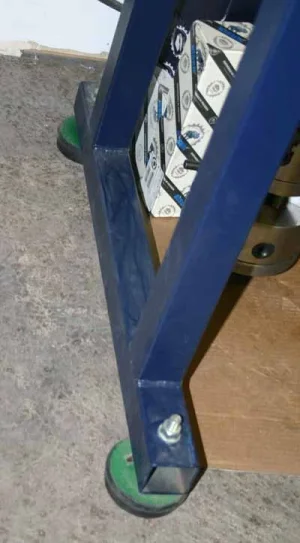jmottle
Member
Hi all,
My first post and until tonight had no idea there was even a Canadian metalworking group! Awesome!
I built out my shop a few years ago and have a TopTech (rebranded Optimum) 10 x 22 lathe (250 x 550) and a Sieg SX3, but I got busy with work, as I'm self-employed, for the last few years and my machines were just sitting there. This year I'm changing that and am currently taking the MACH 213 course at SAIT at night. I'm in the process of building up the list of tooling to add to the shop and getting the machines torn down and cleaned up.
The lathe is done, but now needs to be leveled. I had a few questions though I'm hoping someone might be able to assist with:
1) The lathe stand has 8 holes in the bottom of the support base, presumably for anchoring or leveling mounts, but they are not threaded and are huge - a bit larger than 5/8". Most of the leveling mounts out there assume some sort of threaded hole. The only ones I "think" will work are like (I'd post a links, but am too new):
a) Sunnex OSM series feet
b) GD stem type FootMaster casters
c) Low Profile Industrial Leveling Casters from Atlas Casters


The main issue with all of these are the price. I'm not sure if I can get away with just 4 feet, rather than 8, but each of these feet cost $100-200 each! The feet combined will cost more than the lathe! LOL.
I'd ideally like the ability to roll my lathe if required, but lock it in place
2) The second question I had was about actually leveling the ways. The lathe sits on the top tray of the support base and bolts to it with 3 bolts. One at the tailstock and two at the headstock. All are inline and down the centerline of the lathe bed. I know I'll have to likely shim, but am not sure if it matters that the lathe is not bolting down in the 4 corners.
Thanks for your help! Looking forward to participating more in this group.
Jeff
My first post and until tonight had no idea there was even a Canadian metalworking group! Awesome!
I built out my shop a few years ago and have a TopTech (rebranded Optimum) 10 x 22 lathe (250 x 550) and a Sieg SX3, but I got busy with work, as I'm self-employed, for the last few years and my machines were just sitting there. This year I'm changing that and am currently taking the MACH 213 course at SAIT at night. I'm in the process of building up the list of tooling to add to the shop and getting the machines torn down and cleaned up.
The lathe is done, but now needs to be leveled. I had a few questions though I'm hoping someone might be able to assist with:
1) The lathe stand has 8 holes in the bottom of the support base, presumably for anchoring or leveling mounts, but they are not threaded and are huge - a bit larger than 5/8". Most of the leveling mounts out there assume some sort of threaded hole. The only ones I "think" will work are like (I'd post a links, but am too new):
a) Sunnex OSM series feet
b) GD stem type FootMaster casters
c) Low Profile Industrial Leveling Casters from Atlas Casters
The main issue with all of these are the price. I'm not sure if I can get away with just 4 feet, rather than 8, but each of these feet cost $100-200 each! The feet combined will cost more than the lathe! LOL.
I'd ideally like the ability to roll my lathe if required, but lock it in place
2) The second question I had was about actually leveling the ways. The lathe sits on the top tray of the support base and bolts to it with 3 bolts. One at the tailstock and two at the headstock. All are inline and down the centerline of the lathe bed. I know I'll have to likely shim, but am not sure if it matters that the lathe is not bolting down in the 4 corners.
Thanks for your help! Looking forward to participating more in this group.
Jeff


